Macarons in Paris: Happy Birthday, Ladurée!
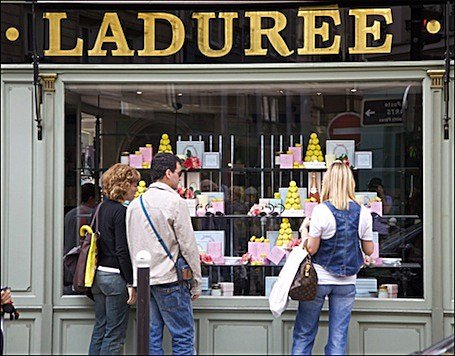
Mon 19 Mar 2012
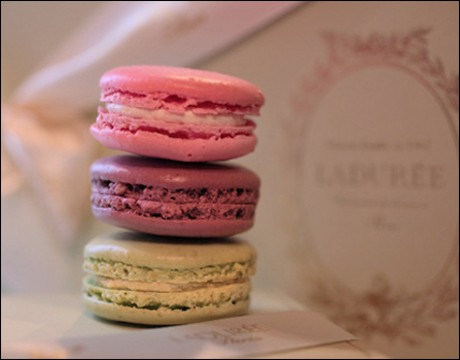
Photo: Courtesy/© Maison Ladurée.
Parisians love few things more than a birthday, but one of those things is the Ladurée macaron. This year they can celebrate these passions together, since 2012 marks Ladurée’s sesquicentennial. It’s also the year their famous biscuit reaches the age of 60. All types of macarons in Paris have their story. But that of the Ladurée macaron is especially Parisian.
In 1862, Louis Ernest Ladurée founded his bakery, installing himself at No. 16, rue Royale. He had chosen the quartier because it was filling with luxury businesses. Around him, a boom economy launched Worth couture, Vuitton luggage, the Café de la Paix, the Hôtel Scribe and the Opéra Garnier.
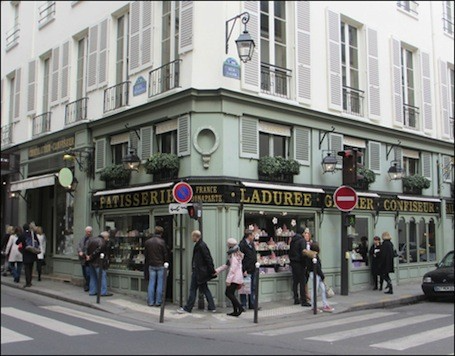
Photo: Steve Sampson.
In 1871, however, Ladurée was destroyed by fire. When Louis and wife Jeanne rebuilt, they focused only on pastry. Around 1900, Jeanne added a salon de thé—a spot where Parisiennes could socialize on their own. Ladurée’s second cousin, Pierre Desfontaines, remade this upstairs in 1930. In 1952, he also made their first macaron.
Six decades later, Ladurée is all celebration. Every month of 2012 will bring a different birthday cake, as well as a new box for the macarons. Plus, in addition to their usual souvenirs (Ladurée perfumes, candles, books, bags and picnic plates), they are offering commemoratives from cards to key chains. Plus there is, of course, a birthday macaron. This is the Incroyable, made in the maison’s celadon green and flavored with those almonds basic to the pastry.
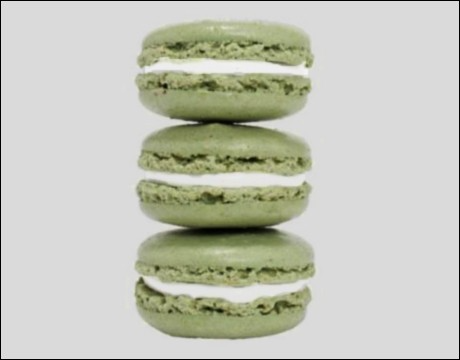
The Incroyable. Photo: Courtesy/© Maison Ladurée.
The rise and rise of Ladurée’s macaron is a triumph of marketing. At its heart is the Holder family, whose bakeries are spearheaded by the ubiquitous Paul. Their eldest son, David Holder, is Ladurée’s president. He and his father bought the company back in 1993—nursing sophisticated plans for the brand.
David dates his passion for Ladurée to the late 1980s. Back then, he was a business student at Paris-Dauphine. Every Saturday, he says, the Holder family lunched together at 16, rue Royale. At the time, he says, “The macarons came in just four flavors. The whole place was classic but out of touch; it had no visual identity.”
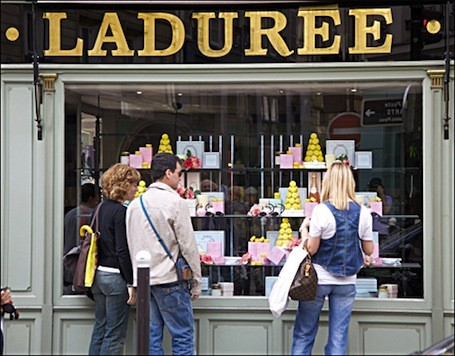
Photo: Steve Sampson.
Groupe Holder took on that task in spectacular fashion. As with Paul, they were respectful of the Ladurée heritage. In fact, it became their ultimate marketing tool. They assigned the group’s design company, Panétude, to analyze the maison’s historic character. The Holders then hired Pierre Hermé as consultant. (Hermé was leaving Fauchon where, for a decade, he had supervised the patisserie.) Only when they felt every piece of their vision was perfect did the Holders start expanding Ladurée. Once they began, progress was swift, with stores opening not just in Paris but also Europe and Asia.
The macaron became the Holders’ secret weapon, able to adapt with every holiday, season or whim. With Pierre Hermé as guru, Ladurée had remade the classic—and customers reveled in the unpredictable flavors and colors. Plus, given elegant packaging that echoed the Second Empire, few sweets in Paris could match their macarons for cachet.
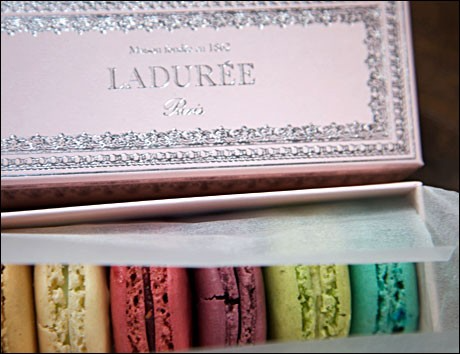
Photo: Steve Sampson.
These days, the Holders run a macaron production line. Eighteen miles south of Paris, in Morangis, their workers turn out 50,000 biscuits a day. Although the press has been known to call it a “factory,” Groupe Holder insists this is a laboratoire. Just a single step in the fabrication, they say, is automated.
A Ladurée macaron costs less than two euros. That makes it, argues David Holder, the perfect budget luxury. Every day, across Paris, hundreds of women agree. So happy birthday, Ladurée—here’s to many more!
• Tuesday, March 20, is the seventh national Day of the Macaron, which benefits autism.
TIP Last October, a fire ravaged Ladurée on the Champs Elysées. Its restaurant remains closed, although takeaway sales continue. Instead, head for 16, rue Royale, in the 8th Arrondissement, or 22, rue Bonaparte, in the 6th.
TIP
In March, a spring “cherry blossom” box by designer Tsumi Chisato is available. This marks Ladurée’s latest fashion collaboration. Other fashion names with whom the house has worked include John Galliano, Christian Louboutin, Christian Lacroix and Matthew Williamson. You can visit Chisato’s shop at 20, rue Babette, in the 3rd.
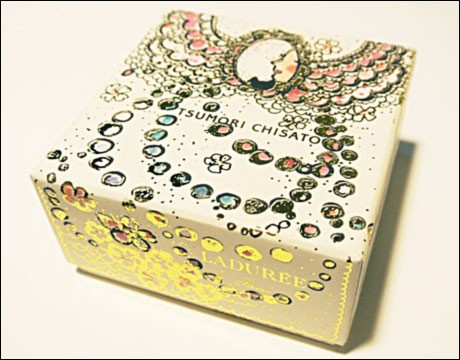
Photo: Courtesy/© Maison Ladurée.
Five things you never knew about Ladurée:
1. Ladurée’s macaron is a macaron parisien, sometimes also called a gerbet. The latter title comes from pâtissier Claude Gerbet of Chartres, whose brother sold their macarons in his Paris shop. Although the gerbet style is made without a filling, the family claims Desfontaines got his “sandwich” format from Claude. They say it came from the pastry he made every Christmas: his chocolate Belle Otero, named for the famous Belle Epoque courtesan.
2. Ladurée’s “signature” pastry is actually the cream puff.
3. The maison now offers 18 permanent flavors of macaron.
4. The kilos and kilos of almonds used in Ladurée’s plant are flown there from . . . California.
5. The flagship macaron creation at Ladurée is l’Ispahan, which encloses fresh raspberries with a ganache made from rosewater and lychee.
Related Links
Ladurée
Louis Ernest Ladurée
Pierre Desfontaine
Pierre Hermé
Tsumi Chisato
La Belle Otero
Editor’s note: Have you downloaded our app of pastry and chocolate shops in Paris yet? It’s the perfectly sweet trip of the finest in the city.